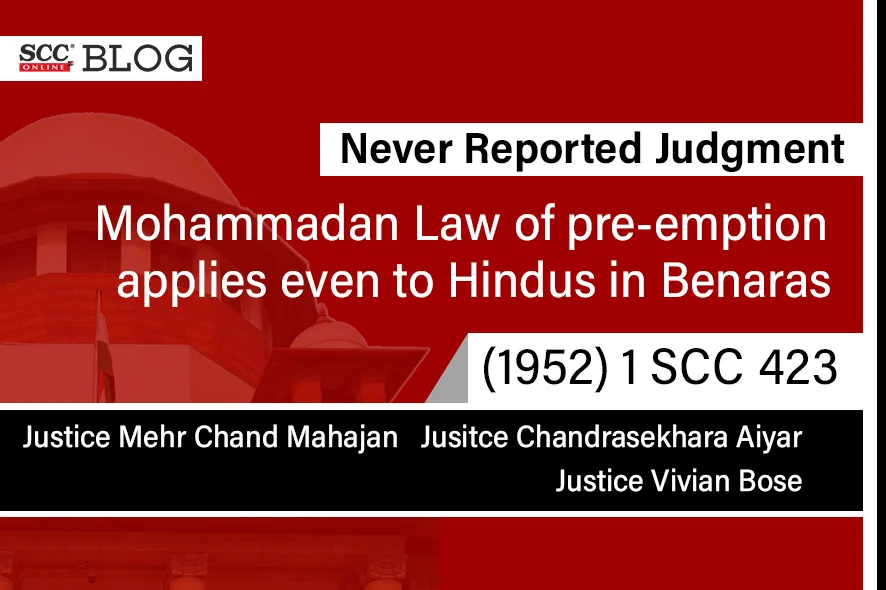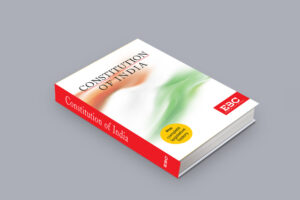Supreme Court: The 3-Judges Bench of Mehr Chand Mahajan, Chandrasekhara Aiyar* and Vivian Bose, JJ., opined that after taking all the documents together and having regard to the language used, there appeared to be little doubt that there was no intention to divide the wall in the manner stated by the Allahabad High Court (‘High Court’). Thus, the Supreme Court agreed with the Subordinate Judge’s decision that the wall was a joint wall and both the appellants, and the vendees were entitled equally, to take the property under the Mohammadan Law of pre-emption. The Supreme Court held that the High Court’s decision that the appellants should get 4/9th was based upon a wrong line of reasoning and the share arrived at by the Subordinate Judge was correct. Thus, the Supreme Court set aside the decrees of the High Court in the two appeals and restored that of the trial court.
Background
In the present case, two appeals had arisen out of a suit brought by the respondents for pre-emption of a house in Benaras, sold by Respondents 4 and 5 to Respondents 1 to 3. The vendees were cousins of the two appellants, and they owned house nos. 13/5 and 13/6. The suit was not defended by the vendors who chose to remain absent, and the vendees, Respondents 1 to 3 resisted the suit. The plan, Ext. K, showed that house nos. 13/3, 13/4 and 24/20 were parts of one mansion; 13/3 and 13/4 were to the north of the wall A-B-X-D, D/1-C. 24/20 was to the north-west of 13/3; house nos. 13/5 and 13/6 belonging to the vendees were to the west. House no. 13/7, which belonged to the appellant, was to the east of house no. 13/6. To the north of the house No. 13/7 and a portion of 13/6 lies the passage E-G, and to the north of it was the wall A-C.
The appellants claimed their right on three grounds, firstly, that they were joint owners and co-sharers to the extent of one-half in the southern party wall; secondly, by virtue of the rights in the passage between the two houses; and thirdly, on account of neighbourhood or vicinage. The respondents denied the appellants’ right of pre-emption and pleaded that the intervening wall between the appellants’ house and the properties sold was not a common wall but had become divided into two halves, the northern half belonging to the vendors and the southern half belonging to the appellants; and thus, there was no joint ownership. The respondents submitted that there were no easement rights as between the respective owners, and the appellants did not make the two demands required by law before they could seek pre-emption.
Analysis, Law, and Decision
The Subordinate Judge gave the appellants a decree for pre-emption for 4/15th of the properties in dispute on appellants paying Rs 5066/10/8 which was 4/15 of the sale price. The Subordinate Judge held that wall A to D belonged jointly to the appellants and the vendors before the sale and that the western portion of it from D-C was the joint property of the vendors and the vendees. It was further held that the appellants had no preferential right of pre-emption as against the vendees; they and the vendees had equal rights as shafi-i-sharik. The exemption of one foot width of land from point A towards the west was a fabricated device to defeat the right of pre-emption, and though nominally reserved, it was intended that it should pass to the vendees under the sale. No right of pre-emption could be based on any easement of support or of light. Both the appellants and the vendees were owners of properties adjacent to the property sold, and the vicinage or neighbourhood rights were the same.
The Subordinate Judge opined that the two demands of talab-i-mowasibat and talab-i-Isshad alleged to have been made by the appellants in connection with the exercise of their right of pre-emption, were true and the formalities prescribed by Mohammadan Law were observed. Out of the three vendees, two were present when the second demand was made, but the third vendee was away and so no demand was made from him. The Subordinate Judge observed that as the demand was made against only two out of the three purchasers, the pre-emption could be only as regards two-thirds of properties sold. Thus, the appellants were entitled to get 2/5th out of 2/3rds, namely 4/15th, on payment of the proportionate amount out of the sale price. Being aggrieved by the Subordinate Judge’s decision, both parties filed appeals to the High Court. The High Court upheld the findings of the Subordinate Judge that house nos. 13/3, 13/4 and 24/20 were one entity or mansion for purposes of pre-emption, and that the rights of easement such as support, or light did not confer a right of pre-emption and that the two demands were made, but only against two of the vendees and not the third.
The High Court concluded that the small strip of land of one foot in width was really excluded from the sale deed as a device permitted by Mohammadan Law to defeat the appellants’ right of pre-emption based on contiguity and that the wall A-D and its continuation westward to the point C must for purpose of title be considered as if it consisted of two parallel adjacent walls, the northern one belonging to the property sold and the southern one from A-D belonging to the appellants and from D westwards to the respondent vendees. Therefore, the appellants had no right of pre-emption, and thus, their suit was dismissed. Thereafter, a petition was filed in the Supreme Court for permission to raise additional ground to the effect that a right to pre-empt contravened Article 19(f) of the Constitution.
The first issue for consideration before the Supreme Court was “whether it had been established that the appellants were joint owners with the vendors of the intervening wall between their property and the property sold?”. The Supreme Court agreed with the Subordinate Judge’s decision that the recitals in the deeds clearly established that it was regarded as a joint wall in which the two owners on the north and the south had a half-share each. The Supreme Court observed that the High Court did not pay sufficient importance to the words “mushtark-bil-monasafa” and if the wall had been divided even notionally along its length between the two owners, the word “mushtark” would have been redundant.
The Supreme opined that “after taking all the documents together and having regard to the language used, there appeared to be little doubt that there was no intention to divide the wall in the manner stated by the High Court and what was actually said in the relevant deeds was that the wall in question was a joint wall in which each of the owners had a half-share. To say that the measurements given in the deed include half the wall was based upon a misconception, namely, that the measurements were accurate, which, however, was not the case, even according to the vendees”. Thus, the Supreme Court agreed with the Subordinate Judge’s decision that the wall was a joint wall and both the appellants, and the vendees were entitled equally, to take the property under the Mohammadan Law of pre-emption.
The Supreme Court noted that the appellants had urged that there was a custom in Benaras that when anyone sold his house, he sold it to the person who had preferential right of pre-emption. The Supreme Court further noted that “according to local custom, a shafi sharik had preferential right against a shafi khalit and a shafi khalit had preferential right against a shafi jar. If both the pre-emptor and the vendee had equal rights, then such a pre-emptor had no right of pre-emption”. Thus, the second issue for consideration before the Supreme Court was “whether the custom of pre-emption in Benaras could modify the rule of Mohammadan Law and could no pre-emption be claimed against persons of equal right?” and the Supreme Court held that the custom pleaded had been found against and the Mohammadan Law of pre-emption applied to the parties, even though they were Hindus in Benaras.
The Supreme Court held that the High Court’s decision that the appellants should get 4/9th was based upon a wrong line of reasoning, namely, that the sale was to be treated as three independent sales of one-third share in the property to each of the three vendees and that each of the respondent vendees could pre-empt the purchase by the other two vendees, but failed to do so. The Supreme Court held that the share arrived at by the Subordinate Judge was correct. Thus, the Supreme Court set aside the decrees of the High Court in the two appeals and restored that of the trial court.
[Lakshmi Das v. Babu Shri Das, (1952) 1 SCC 423, decided on 02-04-1952]
*Judgment authored by: Justice Chandrasekhara Aiyar
Note: Applicability of pre-emption to non-Muslims
The owner of an immovable property has the legal right to purchase another immovable property that has been sold to another party and has the right to repurchase a neighbouring property sold to another party. This is called pre-emption. Section 22 of the Hindu Succession Act, 1956 (‘Act’) governs the preferential right to acquire property in some instances. The “preferential right” remedy under Section 22 of the Act may be used before the selling transaction and according to Section 22, when one co-sharer intends to transfer his share, the other co-sharer may apply to buy that portion. This situation may occur when a co-shareholder gets into an oral or written agreement to sell with a third party. Further, pre-emption rights only apply when immovable property is transferred by sale; they do not apply if it is transferred through a gift, bequest, lease (even if it is perpetual), mortgage, or conditional sale with possession.
Advocates who appeared in this case :
For the Appellants: Bakshi Tek Chand, Senior Advocate (Saiyid Murtaza and Fazl Ali, Advocates with him)
For the Respondents: G.S. Pathak, Senior Advocate (Krishna Shankar, Advocate, with him)







